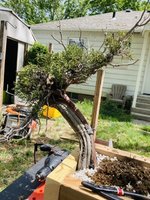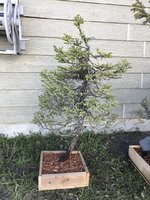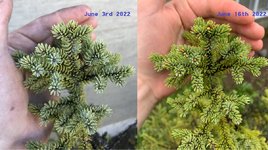JPH
Mame
June has been rough going. Within only a few weeks of each other I lost five of my six collected Black spruce. All of the symptoms were the same. Sudden drying of the needles followed by yellowing and finally massive needle drop. It's a little heartbreaking as I was excited about them, but I need to look at this in a logical way. I obviously did something wrong. So changes must be made to how I collect and care for these trees. I'm hoping this will be a valuable learning experience. I don't believe in hiding my failures.
Here are some key points.
- All but one of the trees were collected in late fall. About a month before the first snow. The other tree was collected in early spring.
- Most of these trees had excellent root systems when they came out of the ground. None were bare rooted.
- They were planted in wooden boxes made from recycled pallet wood (not pressure treated or painted).
- The substrate for all but one was 1/4" fir bark. Good drainage and doesn't decompose quickly. One of the smaller trees was planted in pure living sphagnum (this tree had poor roots but was the last to die...).
- All trees appeared to survive winter and spring. It was only during June that they rapidly declined.
- They were watered attentively. Kept moist but not sopping wet. I also misted the foliage to maintain humidity.
- In the Fall, I had my trees on a table I built from scrap wood, but later moved them to the ground.
- They were placed on the leeward side of the house, protected from the harsh wind, and received morning sun/afternoon shade.
- Interestingly, my Tamaracks are doing just fine and pushing new needles like crazy. They were treated the same way.
- I have one Spruce left which was collected later in the season. I'll admit that I did a much better job at transplanting this one. But I'll be watching it very closely.
So, what do you think? I have a few hypotheses.
1. Collecting Spruce in late fall might have been a mistake. Since they put on most of their root growth in the fall season, I might have undone what the tree worked hard to build during the previous weeks/months.
2. Heat sensitivity. Is it true that Spruce move water much less efficiently than a Tamarack (Larch)? This coupled with root damage during collection may have prevented the Spruce from cooling themselves adequately.
3. Root damage from the cold? They appeared totally fine in the spring. However they showed no signs of new growth.
4. Too rough/aggressive with the roots + Poor anchoring. Many of my earlier trees wobbled a lot. I've since become much better at anchoring my trees.
Please let me know your thoughts.
Here are some key points.
- All but one of the trees were collected in late fall. About a month before the first snow. The other tree was collected in early spring.
- Most of these trees had excellent root systems when they came out of the ground. None were bare rooted.
- They were planted in wooden boxes made from recycled pallet wood (not pressure treated or painted).
- The substrate for all but one was 1/4" fir bark. Good drainage and doesn't decompose quickly. One of the smaller trees was planted in pure living sphagnum (this tree had poor roots but was the last to die...).
- All trees appeared to survive winter and spring. It was only during June that they rapidly declined.
- They were watered attentively. Kept moist but not sopping wet. I also misted the foliage to maintain humidity.
- In the Fall, I had my trees on a table I built from scrap wood, but later moved them to the ground.
- They were placed on the leeward side of the house, protected from the harsh wind, and received morning sun/afternoon shade.
- Interestingly, my Tamaracks are doing just fine and pushing new needles like crazy. They were treated the same way.
- I have one Spruce left which was collected later in the season. I'll admit that I did a much better job at transplanting this one. But I'll be watching it very closely.
So, what do you think? I have a few hypotheses.
1. Collecting Spruce in late fall might have been a mistake. Since they put on most of their root growth in the fall season, I might have undone what the tree worked hard to build during the previous weeks/months.
2. Heat sensitivity. Is it true that Spruce move water much less efficiently than a Tamarack (Larch)? This coupled with root damage during collection may have prevented the Spruce from cooling themselves adequately.
3. Root damage from the cold? They appeared totally fine in the spring. However they showed no signs of new growth.
4. Too rough/aggressive with the roots + Poor anchoring. Many of my earlier trees wobbled a lot. I've since become much better at anchoring my trees.
Please let me know your thoughts.



